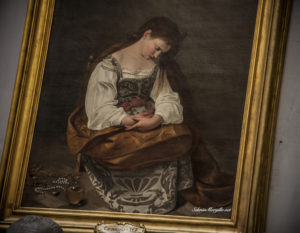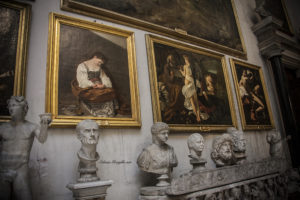Penitent Mary Magdalene by Caravaggio
Italian Version below*
In the first years of his Roman stay, located in the period from 1590/92 to 1606, Caravaggio painted, for a still uncertain client, the painting of the Penitent Magdalene.
(Part of the criticism attributes it to Cardinal F. Maria del Monte).
In a completely bare environment, he seated the figure of this young woman sitting on a chair.
The model was a famous young courtesan, Anna (Annuccia) Bianchini, of Tuscan origins and well known in Rome.
Caravaggio certainly met her in the Campo Marzio area, the so-called “Ortacci”, a place of taverns and prostitution. The two intertwined a relationship that lasted over time and was quite turbulent. The artist portrayed it in several works including the famous Rest during the Flight into Egypt (Galleria Doria Pamphilj).
Caravaggio interprets the religious theme in a purely domestic key, staging everything he had learned in his youth during his Lombard training, at the workshop of Simone Peterzano.
The geometry and spatiality of the environment are highlighted only by the tiles in the foreground which slowly fade into the background and intersect with the two beams of light that evoke at the same time the “divine” aspect.
The woman’s clothes are an important testimony of the daily life that was breathed in Rome at the end of the 1500s.
The few objects placed on the ground on the tiles, the pearl necklace, the ointments and the incredible detail of the tear that furrows the face, are a perfect snapshot of the “reality and truth” that Caravaggio pursued in all his works and which allow us to define the young woman as a “Magdalene”.
In 1627 the painting was inventoried as the property of Cardinal Aldobrandini and became following the marriage of Olimpia Aldobrandini to Camillo Pamphilj, part of Doria Pamphilj collection.
Giovanni Bellori, one of the greatest biographers of the painters of the seventeenth century in Rome wrote: “He painted a girl sitting on a chair with her hands in the process of drying her hair, he portrayed her in a room, and adding a jar of ointments to the ground, with jewels and gems, he pretended for Maddalena “.
InfoSite: Doria Pamphilj Gallery
If you are in Rome do not miss the opportunity to visit the Doria Pamphilj Gallery with RomaOperaOmnia and the fascinating experience of Sounds and Visions of Caravaggio!!!
All rights reserved*
Nei primi anni del suo soggiorno romano, collocato nel periodo dal 1590/92 al 1606, Caravaggio dipinse, per una committenza tutt’ora incerta, il dipinto della Maddalena penitente. (Parte della critica lo attribuisce al Cardinale F. Maria del Monte).
In un ambiente completamente spoglio collocò seduta su di una seggiola, la figura di questa giovane donna.
La modella era una famosa, giovane cortigiana, Anna (Annuccia) Bianchini, di origini toscane e molto nota a Roma.
Caravaggio la incontrò sicuramente nell’area del Campo Marzio, i c.d. “Ortacci”, luogo di osterie e prostituzione.
I due intrecciarono una relazione che si protrasse nel tempo e che fu abbastanza turbolenta. L’artista la ritrasse in diverse opere tra cui il celebre Riposo durante la Fuga in Egitto (Galleria Doria Pamphilj).
Caravaggio interpreta il tema religioso in una chiave prettamente domestica, mettendo in scena tutto ciò che aveva appreso in gioventù durante la sua formazione lombarda, presso la bottega di Simone Peterzano.
La geometria e la spazialità dell’ambiente sono evidenziati solo dalle mattonelle in primo piano che lentamente sfumano sullo sfondo e si incrociano con i due fasci di luce che evocano al contempo l’aspetto “divino”.
Gli abiti della donna sono un’importante testimonianza della quotidianità che si respirava a Roma sul finire del 1500.
I pochi oggetti posti a terra sulle mattonelle, la collana di perle, gli unguenti ed il dettaglio incredibile della lacrima che solca il viso, sono una perfetta istantanea della “realtà e del vero” che Caravaggio perseguiva in ogni suo lavoro e che ci consentono di definire la giovane donna come una “Maddalena”.
Nel 1627 il dipinto fu inventariato come proprietà del cardinale Aldobrandini e divenne in seguito al matrimonio di Olimpia Aldobrandini con Camillo Pamphilj, parte della collezione Doria Pamphilj.
Giovanni Bellori, tra i maggiori biografi dei pittori del Seicento Romano scrisse: “Dipinse una fanciulla a sedere sopra una seggiola con le mani in seno in atto di asciugarsi i capelli, la ritrasse in una camera, ed aggiungendovi in terra un vasello d’unguenti, con monili e gemme, la finse per Maddalena”.
InfoSite: Galleria Doria Pamphilj
Se sei a Roma non perdere l’occasione di visitare la Galleria Doria Pamphilj con RomaOperaOmnia e l’affascinante esperienza di Sounds and Visions of Caravaggio!!!

